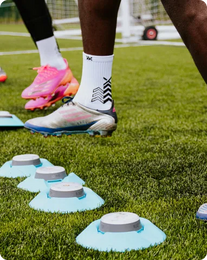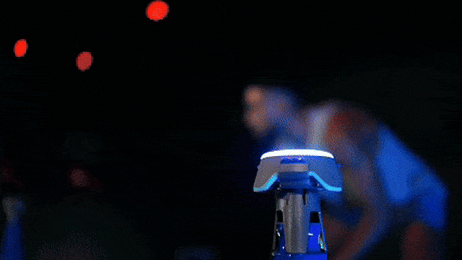The 4 3 2 1 formation, also known as the “christmas tree,” is among other modern systems that employ a 5-man midfield. One of its real beauties is that it relies heavily on triangular combinations with short and long passes that leave opponents miserable.
We rarely spot this lineup as we’d expect nowadays- and this is quite shocking since the 4 3 2 1 formula is considered a nicely balanced soccer defensive formation with tons of possibilities.

This Christmas tree formation was common in the 90s. But it first came into the limelight during the 1998 World Cup finals when France used it against a Brazil side to win its first world cup. Lined up against Brazil’s 4-2-2-2 formation with Ronaldo and Bebeto as the strikers, the Aimé Étienne Jacquet-led French squad had Barthez as the goalkeeper and Zidane and Djorkaeff as the offensive midfielders supporting Guivarc’h as the striker.
Get your BlazePod®
SHOP NOWIt was also quite popular with Christian Gross and Terry Venables during their time at Tottenham Hotspur. But more than any other proponent, the mention of 4 3 2 1 soccer formation tactics takes us down memory lane to when AC Milan under Carlo Ancelloti ruled Europe using this formula and its variations.
Hands down, AC Milan’s most memorable usage of this soccer defensive formation is when they beat Liverpool 2:1 to win the 2007 UEFA Champions League in Athens, Greece. Liverpool had lined up a 4 2 3 1 system (analyzed here) with Steven Gerrald as one of the 3 creatives and Kuyt as the striker.
For this 4 3 2 1 formation guide, we look at what makes this formation special, how it’s played, and its significant strengths and weaknesses.
4 3 2 1 Soccer Formation Tactics- How to Play
The 4-3-2-1 is a narrow formation that starts with 2 center-backs and 2 fullbacks shielding the goalkeeper. The midfield is manned by 5 players consisting of 3 center midfielders sitting behind a pair of attacking midfielders. At the front is the center forward, who plays as the only striker.
The 2 things that clearly come out in 4 3 2 1 soccer formation drills are the obvious lack of width and the lone striker. That being said, if you’re planning to implement this formula, it’s critical that you borrow a leaf from its maestro- Ancelloti- to see how he used player positioning to tackle these limitations and beat the most daring soccer offense formations.
Get your BlazePod®
SHOP NOWPlayer Roles in 4 3 2 1 Formation
Goalkeeper
As with any other structure, the goalkeeper is the last line of defense. So, they need to be well cut out for this role. In a 4321 lineup, the roles of the goalkeeper go beyond catching balls and preventing goals. Importantly, the goalkeeper is tasked with managing the defense block by directing the back 4 to fill any openings that are likely to cause problems.
The keeper's positioning in relation to the defense wall is of significant importance to the success of 4 2 3 1 soccer formation tactics. Ideally, you want the goalie to slide a distance from the goal to be able to pick up passes from the center-backs and fullbacks. This makes the keeper a sort of a sweeper or libero. Manuel Neuer of Bayern Munich is one heck of an international goalkeeper who does this so well.
To create a sense of confidence in the team, you want a generally physically imposing goalkeeper. And as modern soccer dictates, the goalie also needs to possess impeccable foot skills and passing techniques. This is particularly important as the keeper will often be solicited to build the play from the back by passing the ball to the fullbacks.
2 Central Defenders
As one of the most defensive soccer formations today, this system features a 4-player defense wall comprising 2 central defenders and a right and left fullback each on their respective side. Of the 2 central defenders, it’s common to have a sweeper and a stopper.
The sweeper is the last defender before the goalie, so they need to be one of the most reliable players in your team. Sweepers are responsible for controlling the back and backing up the other defense players at all times. This position requires fast, smart, and skilled players who can do it all, from stopping breakaways from happening to clearing the ball with their heads and opening up space for the forwards.
Equally important is the stopper. Although speed is not critical for these players, they need to have a comparably larger build. But even more important is the need to be consistent when tackling opposing players and ball distribution. This is because stoppers are required to strip oncoming opponents of the ball before passing it to other teammates.
2 Fullbacks
As mentioned before, the lack of natural width is usually the most inherent issue with the 4 3 2 1 formation. But this is where the fullbacks come in. While these players are expected to help with the defense, this formation also requires them to bombard up the flanks to put in dangerous crosses before tracking back to tackle the opponents.
Needless to mention, the right and left fullbacks need to have the engines to track back and forth the length of the pitch for the whole 90 minutes. That’s to say that they need to be extremely fit and have excellent ball control on the fly. Of course, being fast also helps massively.
In his AC Milan days, Ancelloti often picked Cafu- the most decorated right back ever- aided by the 2007 Czech Football of the Year, Marek Jankulovski.
3 Center Midfielders
The center midfield is where the magic happens. These 3 players have 4 major roles: protect the D, link the midfield to the attack, support attacks, and create chances. In a 4 3 2 1 formation, the player at the middle of the central midfielders acts as the deep-lying playmaker (DLP).
The DLP literally holds the entire midfield together and is responsible for linking the midfield besides being defensive-minded. To make this possible, the deep-lying midfielder needs to be an energetic shuttler with an excellent range of passing.
To maximize this format’s potential, it’s important that the DLP has less of a defensive burden in order to put more effort into linking the midfield with the players at the front. To set the stage for the DLP, they will need a strong, intelligent, and defensively sound box-to-box player on one side and a ball-winning midfielder (BWM) on the other side. The latter is supposed to possess the necessary technical skills needed to win the ball and accurately lay it off to other creative teammates.
During his time at AC Milan, Andrea Pirlo (currently Juventus head coach) was Ancelotti’s top favorite deep-lying playmaker thanks to his unbeatable ball control, vision, creativity, technique, and passing, among other strengths.
2 Offensive Midfielders
Although the offensive midfielders are also involved in protecting the D and linking, they are more into creating goal-scoring chances and supporting attacks. Other vital roles of offensive midfielders in a 4 3 2 1 formation include adding width when the team is in possession, offering constant support to the striker, and finishing off attacks.
To excel in this position, you want players with exceptional dribbling, shooting, and passing skills. If you analyze Clarence Seedorf and Kaka’s gameplay (2 of the world’s best offensive midplayers), you’ll realize that they also boast a strong mentality that’s needed to motivate the entire team. These are some of the things that you want to pay special attention to in your 4 3 2 1 soccer formation drills.
Striker
The star on top of the christmas tree formation is expected to finish the job of the other players. Depending on the type of players available in your team, you can opt for a classic big-target striker. This needs to be a tall player who can receive aerial balls and feed it to the offensive midfielders before bombing forward to get into the box to receive crosses and cut-backs.
You could also go for a mobile striker. The latter seeks to cause havoc in the final third by using their speed and technical skills to weaken the opposing team’s defense by stretching their back wall.
Regardless of the type of player you have at your disposal, the 4 3 2 1 formation requires a goal poacher. The striker should be strong to keep defenders at bay and confident that they are going to score with each shot. The player should also have explosive speed and be quick at PDE (perception, decision, and execution).
4 3 2 1 Formation Strengths and Weaknesses
Pros
Fluidity
This soccer formation’s key attribute is that it allows players to take over dissimilar positional responsibilities mid-match. Although the players have specific roles to play, the ability and license to focus on other areas help a lot, depending on the circumstances.
Versatile
Another beauty of the 4 3 2 1 formation is that the midfield can be re-engineered depending on what you want to achieve. For instance, provided there’s adequate communication to avoid overcrowding the midfield, the players could easily regroup into a soccer defensive formation, such as 4 5 1 or 4 2 3 1, which boasts a more attacking approach.
Outnumbering the opponents
With 5 midfield players standing in 2 lines, it’s very easy for the players to converge and suffocate the opponent.
Great for counterattacks
Being able to dominate the midfield not only increases ball possession it also creates lots of triangular passing options that make it easy to launch counterattacks.
Get your BlazePod®
SHOP NOWCons
More pressure on strikers
Although there’s strength in having more players in the midfield, this formula also leaves the team deprived of players at critical areas of the pitch. For instance, there’s a lot of pressure on the lone striker to stand out and score.
Dangerous gaps on the sides
While the fullbacks are expected to add width to the team, dangerous gaps are left when they bomb forward. These spaces can pose a huge problem, for instance, if the fullbacks get wrapped on offensive attacks and forget to track back to defend.
Take your 4 3 2 1 soccer formation drills a notch higher with the Blazepod Flash Reflex Lights and Reaction Training System. With its perfect combination of engaging light-based pods, motivating visual cues, and pre-loaded professionally-designed activities, Blazepod is the perfect technology to help your clients get the most out of their training sessions.
























